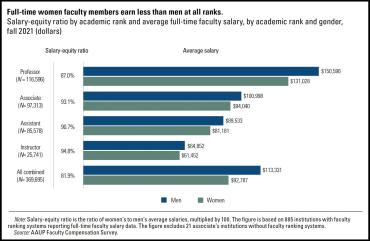Full-time faculty pay is dipping more than it ever has, and inequities continue to plague the profession, according to a new report from the American Association of University Professors. Meanwhile, more than half of the faculty in the United States are working on a contingent basis, and average pay for adjuncts is as low as $2,979 per course at public associate institutions.
The AAUP’s “Annual Report on the Economic Status of the Profession, 2021-22” headlines falling wages for full-time faculty: While they increased 2 percent in 2021-22, after taking inflation into account, real wages for full-time faculty decreased 5 percent—the largest one-year decrease on record since the AAUP began tracking this measure in 1972. Meanwhile, women earned just 81.9 percent of what their male colleagues earned, and data shows the deepest disparities are in the higher ranks of the profession.
“Collectively, these data sources paint a bleak economic picture of the profession,” the AAUP concludes in a summary of the report. “Deteriorating wages of college and university faculty members in relation to the wages of other professions, continued gender pay inequality, appallingly low pay for adjunct faculty members, erosion of the financial structures that support higher education, rising threats to academic freedom and shared governance, and continued uncertainty about the COVID-19 pandemic—all threaten the standards of the profession and the quality of higher education itself.”
To interrupt the downward spiral, the AAUP calls on faculty, administrators, associations, labor unions, elected officials and citizens to “demand access to relevant data to inform policy decisions. … We can break the cycle only through up-to-date, objective, reliable demographic data and complete transparency regarding faculty compensation and working conditions, combined with collective action focused on social justice.”
The general picture
The report takes a careful look at the last two years, describing the “swift and severe” impact of COVID-19 on higher education as one element in the “existential threat” that has included not just decreased pay but plummeting student enrollment, faculty and staff layoffs, and uncertain state budgets. Recovery has been slow, though by January 2022 employment at colleges and universities had climbed back to 90.2 percent from February 2020.
The dependence of public colleges and universities on state appropriations is significant as well. Because of key federal stimulus funding, higher education funding was maintained in many states, at least in the short term. But high inflation rates are likely to change that equation.
Inequity persists
In the midst of the downturn, inequity means some people are hit harder than others. The AAUP report shows that full-time faculty who are women earn 81.9 percent of what their male colleagues earn. On average, across professorial ranks, women earn $92,787 compared with men’s pay, at $113,331. The gap is bigger for those working at the higher ranks, such as full professor, compared with lower ranks, such as instructor.
The number of women who are full-time faculty has reached nearly half the entire cohort of full-time faculty (48.1 percent), but rank also influences the numbers here: There are fewer women who make full professor and associate professor, compared with assistant professor and instructor. Women represent 35.8 percent of all full professors, 47.4 percent of associate professors, 53.6 percent of assistant professors, and 57.6 percent of instructors.
The study, which was based on the AAUP’s own Faculty Compensation Survey and data from the U.S. Department of Education’s Integrated Postsecondary Education Data System and other sources, did not include information about pay differences by ethnicity and race. But a 2020 AAUP analysis notes the general dearth of Black and Latinx faculty—just 6 percent of full-time faculty members identified as Black, when the broader population (of people ages 24 to 64) was 12.7 percent Black. Similarly, 5.2 percent of full-time faculty were Latinx compared with 17.5 percent in the general population.
Given these inequities, the AAUP wrote, “we can infer the existence of a racial pay gap overall, even though IPEDS does not directly collect faculty salary data by race and ethnicity.”
Broader salary data would support that conclusion. The American Association of University Women reports that nationally, women overall earn 81 percent of what white men earn, but the gap widens dramatically for women of color. Latinas earn 49 percent of what white men earn; Native women, 50 percent; Black women, 58 percent; and Asian American, Native Hawaiian and Pacific Islander women, 75 percent. There was no data reported on nonbinary or trans faculty.
More specifically, a 2017 study of faculty wages, published in Educational Researcher by researchers from the University of Missouri, showed wage gaps of $10,000 to $15,000 between white and Black faculty.
More adjuncts, less pay
Universities continue to lean heavily on contingent faculty—those who are not on the tenure track and whose jobs depend on “contingent” factors such as course demand and budget. In the fall of 2020, about 3 in 5 faculty members were contingent—that’s 61.5 percent. Faculty members in these appointments—which frequently mean low job security and low pay—are more likely to be women and people of color.
Among those contingent workers are adjunct faculty, who work part time or cobble together multiple part-time positions to equal a full-time work schedule, often at a fraction of what tenure-track or tenured faculty earn. Average pay for adjuncts in 2020-21 ranged from $2,979 per course in public associate’s institutions without ranks, to $5,557 in public doctoral institutions. These figures confirm the AFT’s 2022 report, “An Army of Temps: AFT Adjunct Faculty Quality of Work/Life Report,” which shows nearly 4 in 10 adjuncts need government assistance to get by, a quarter earn an annual salary below the federal poverty line, and nearly half struggle with extreme job insecurity.
The AAUP report also examines retirement, medical and tuition remission benefits and administrator salaries.
For more details and context, read the entire report, “The Annual Report on the Economic Status of the Profession, 2021-22.” An interactive AAUP Faculty Compensation Survey Results Tool, with data from 2019-20 through 2021-22, is available here. Appendices with average pay and benefits data for each participating institution are also available.
[Virginia Myers]


